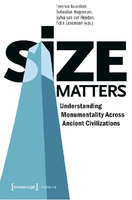Size Matters – Understanding Monumentality Across Ancient Civilizations
Contributor(s)
Buccellati, Federico (editor)
Hageneuer, Sebastian (editor)
van der Heyden, Sylva (editor)
Levenson, Felix (editor)
Language
EnglishAbstract
When talking about monuments, size undeniably matters – or does it? But how else can we measure monumentality? Bringing together researchers from various fields such as archaeology, museology, history, sociology, Mesoamerican studies, and art history, this book discusses terminological and methodological approaches in both theoretical contributions and various case studies. While focusing on architectural aspects, this volume also discusses the social meaning of monuments, the role of forced and free labour, as well as textual monumentality. The result is a modern interdisciplinary take on an important concept which is notoriously difficult to define. When talking about monuments, size undeniably matters – or does it? But how else can we measure monumentality? Bringing together researchers from various fields such as archaeology, museology, history, sociology, Mesoamerican studies, and art history, this book discusses terminological and methodological approaches in both theoretical contributions and various case studies. While focusing on architectural aspects, this volume also discusses the social meaning of monuments, the role of forced and free labour, as well as textual monumentality. The result is a modern interdisciplinary take on an important concept which is notoriously difficult to define.
Keywords
Monumentality; Architecture; Energetics; Identity; Labour; Monument; Perception; Reception; Cultural History; Ancient History; History; Monumentality; Architecture; Energetics; Identity; Labour; Monument; Perception; Reception; Cultural History; Ancient History; HistoryDOI
10.14361/9783839445389ISBN
9783837645385OCN
1114827556Publisher
transcript VerlagPublisher website
https://www.transcript-verlag.de/Publication date and place
Bielefeld, 2019Series
Histoire, 146Classification
Ancient history


 Download
Download Web Shop
Web Shop